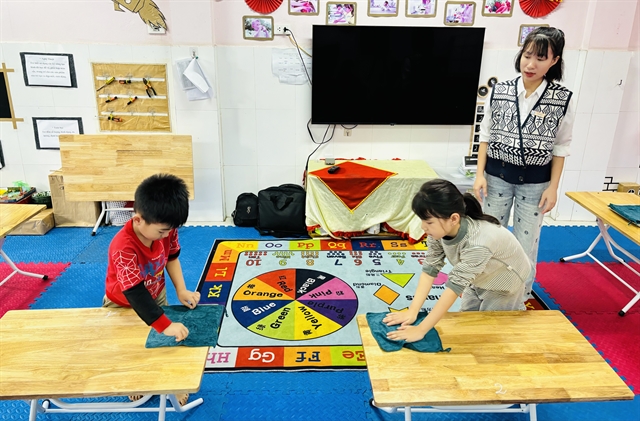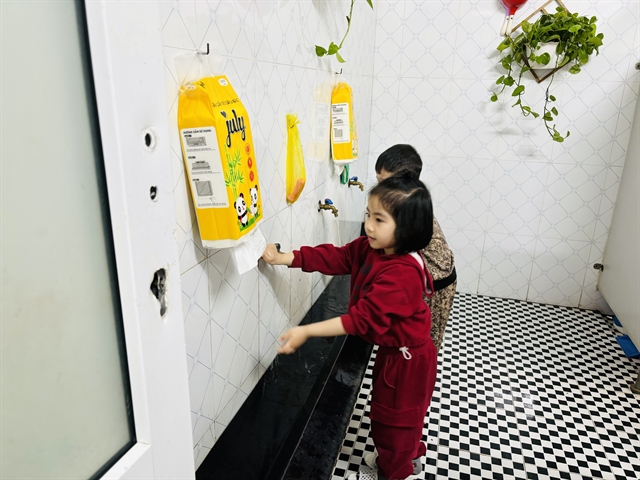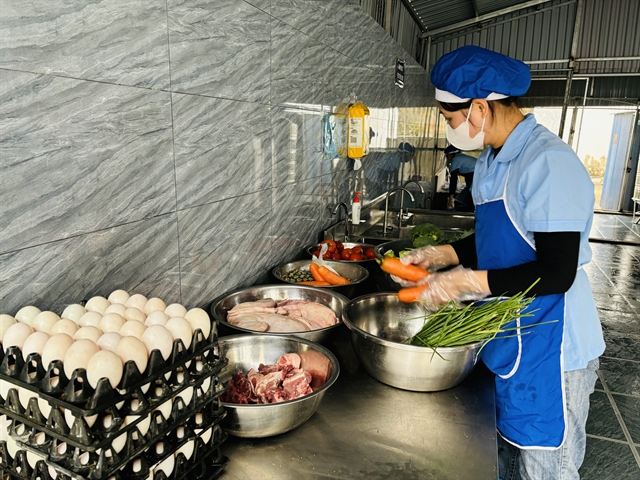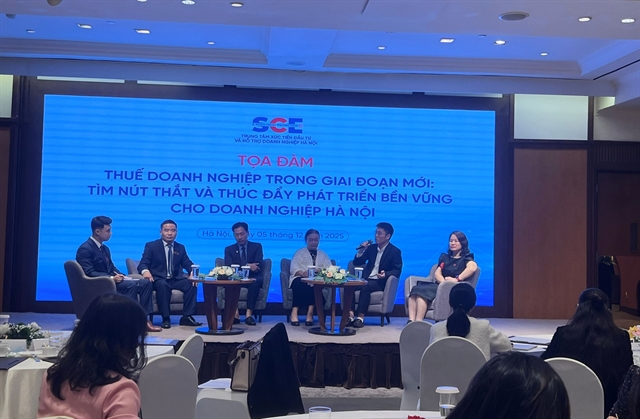 Society
Society

Khánh Dương
HÀ NỘI — It's 11.30am at Liên Châu Preschool in Thanh Oai District, Hà Nội, and that means lunchtime.
Meals have been delivered to each classroom, but the children are not rushing to get their hands on them.
Instead, they calmly line up to wash their hands and prepare towels to clean their dining tables.
Tú Anh, a five-year-old student, repeats the five steps she and her classmates have learned by heart before every meal:
“Step 1: Get a clean towel ready.
Step 2: Set aside everything that isn't needed.
Step 3: Wash your hands.
Step 4: Clean the table.
Step 5: Wash your hands again.”
From preschool
In Thanh Oai District alone, more than 20,000 children from 32 preschools have been introduced to food safety practices through the Safe Food for Growth (SAFEGRO) project, funded by Global Affairs Canada.
Knowledge on food safety has been turned into compelling tales, tunes, poetry, interactive games and entertaining experiential activities.
Food safety has become ingrained in children's everyday routines thanks to the 'Learning through play' approach, encouraging them to adopt positive food safety behaviours and ensuring better hygiene in school and when they are at home.
Đào Hải Trang, a five-year-old at Cao Viên Preschool, said: “Before eating, we must wash our hands, wash our faces and wipe the table. Our teachers also teach us to wash fruit and separate raw and cooked food before storing them in the fridge.”
Beyond basic hygiene, the children also learn to understand how germs spread.
Preschool teachers who have taken SAFEGRO’s food safety training are passing this knowledge on to their students, helping close the gap in both understanding and practice, and sharing the approach with colleagues in other schools.
 |
| Children at Liên Châu Preschool in Thanh Oai District, Hà Nội, clean their dining tables before lunch. — VNS Photos Khánh Dương |
Phạm Thị Hoa, principal of Cao Dương Preschool, told Việt Nam News: “Food safety culture must be instilled from early childhood through to old age. Teachers must set an example and help children build these habits every day.”
“Preschoolers learn through play, experiencing lessons hands-on. Teachers apply their training to help children recognise safe and spoiled food. And these little learners don’t stop there — they take their knowledge home, teaching their families too!”
Đoàn Việt Dũng, head of Thanh Oai District’s Department of Education and Training, said food safety and hygiene should become routine for all students, teachers and staff.
“Children should always think about personal hygiene before they eat or drink to build lifelong habits,” he added.
Thanks to SAFEGRO’s training, food safety awareness has extended beyond the classroom, reaching both teachers and parents, and is contributing to the progression of food safety culture.
Nguyễn Thị Nga, vice principal of Cự Khê Preschool, said: “I used to put all food together in the refrigerator after shopping. Now, I separate cooked and raw food and store them properly in different containers.”
Tạ Thị Ngọc, whose three-year-old son attends Cao Viên Preschool, was surprised when he recently reminded her to wash her hands before dinner.
“He even washes apples himself and warns me not to keep rotten fruits in the fridge,” she said.
“After school, he reminds me to change clothes to avoid bringing in germs. He also tells us to wash fruits and soak them in salt water before eating. He shares so much food safety knowledge that he learned in class.
“Not just that, my child now tidies up his clothes and shoes neatly. Whatever the teachers say, he passes it on to us, as if he has become our food safety little teacher!”
These practical lessons have been structured within a food safety education framework, incorporating key messages on food safety principles, objectives, and methods. Using the ‘Learning through Play’ approach, food safety education will help preschoolers integrate this topic into the curriculum flexibly. This serves as a great starting point for introducing food safety education into the new preschool curriculum that the Ministry of Education and Training plans to implement in coming time.
To further support these efforts, SAFEGRO has also upgraded kitchen facilities in preschools across Thanh Oai District, installing stainless steel tables, dish dryers and water purifiers, while improving food safety practices and culture through training among kitchen staff.
 |
| Children at Liên Châu Preschool clean their hands before lunch. |
To university
Food safety education doesn't stop at preschool. It has also been incorporated into university curricula for students majoring in food science, technology and quality management - many of whom will become future leaders in the food industry, promoting organisational food safety culture.
With support from SAFEGRO, practical, updated and internationally-aligned teaching materials have been developed for university courses while short-term in-service food safety training programmes are expected to be applied at businesses, industrial parks and food safety agencies.
The courses cover key topics in risk analysis, food inspection, food autheticity and traceability, hygienic design in food industry, food safety management systems, quality assurance, food safety culture and leadership in food safety.
Last month, around 70 lecturers from universities nationwide gathered in Khánh Hòa Province’s Nha Trang City to review and adopt newly developed lectures, which they are expected to incorporate into their teaching in the coming years.
According to Associate Professor Trần Thị Định from Faculty of Food Science and Technology, Việt Nam National University of Agriculture, one of the course’ developers, these are the first nationally-standardised lecture materials on food safety in Việt Nam which align with international standards.
Once finalised, SAFEGRO will distribute the lecturing materials to universities nationwide, enabling them to share resources that meet international standards while remaining tailored to Việt Nam’s context. These materials will be made available to all universities in Việt Nam as free open-source content through SAFEGRO’s website in Vietnamese and English.
The next goal is to convert these lectures into e-learning formats, making them accessible not only to Vietnamese students but also learners across the region and beyond, she said.
The teaching materials’ developers said they support instructors in using active teaching strategies, which incorporate case studies, examples and real-world research in addition to theoretical knowledge to demonstrate the ideas.
Professor Lawrence Goodridge, director of the Canadian Research Institute for Food Safety at the University of Guelph, emphasised the value of using real examples in education.
“We know food safety issues happen everywhere,” he said.
“In Canada last year, we had several foodborne disease outbreaks. I use those cases in my lectures to show students that food safety is not just theory, it applies to real life.”
Nguyễn Thị Minh Tú, a lecturer at Hà Nội University of Science and Technology, said she was especially interested in the module on food safety culture.
“Food safety culture is a new concept for us,” she explained.
“It’s always existed, but we haven’t emphasised it. This is the first time it has been standardised in university teaching materials, and I hope to add it to my courses soon.”
 |
| A member of the kitchen staff at Liên Châu Preschool classifies food in the morning before cooking lunch for children. |
Sustainable food safety culture
SAFEGRO’s efforts to build food safety awareness from preschool through university have been praised as a sustainable model. The progression of food safety culture in Việt Nam is at an early stage. This curriculum will begin the process to understand and promote the adoption critical food safety behaviours across the full spectrum of the agri-food sector.
Professor Lawrence said: “Food safety education must involve everyone, not just students or food producers, but the general public. In Canada, we’ve seen that foodborne illnesses often start in home kitchens because people don’t handle food properly. But parents listen to their children.
“When we teach children about food safety, they bring those lessons home. We believe the same will happen in Việt Nam by starting with preschoolers.”
As these children grow, their food safety awareness will mature, gradually transforming the broader culture of food safety, he said.
Nguyễn Văn Thuận, head of the Quality and Organic Agriculture Division, National Agro-Forestry-Fisheries Quality Assurance Department under the Ministry of Agriculture and Environment, praised SAFEGRO’s long-term impacts.
“The project’s name, Safe Food for Growth, reflects its focus on the future,” he said.
“Việt Nam has over 10 universities offering programmes in food science and technology. Every year, thousands of students graduate in these fields.
"SAFEGRO’s training materials will give them practical knowledge and experience they can apply immediately in regulatory agencies, research institutes or businesses. We hope these graduates will continue spreading their knowledge, training future generations of workers."
“That’s the lasting value and potential of this project," he said.
Dr Fred Unger, a senior scientist and regional representative of International Livestock Research Institute (ILRI) in Asia - one of SAFEGO’s partners, said food safety education is a key aspect to improve public awareness, and it may also lead to an increasing demand for safer food by consumers.
He said key food safety messages should be developed with the involvement of various sectors like the Ministry of Health, Ministry of Agriculture and Environment, Ministry of Education and involve expertise on social science, behavioral change, risk communication and media in a truly interdisciplinary and sectoral approach. Those efforts can already start in school programmes like the one initiated by SAFEGRO. — VNS




